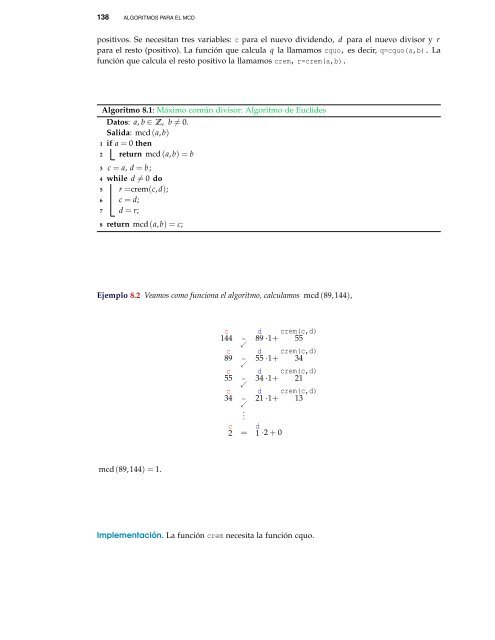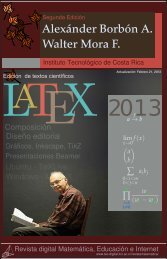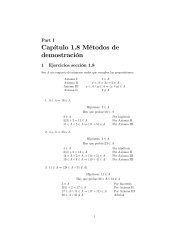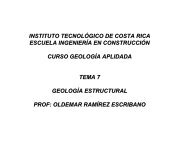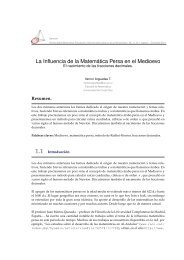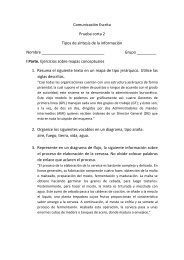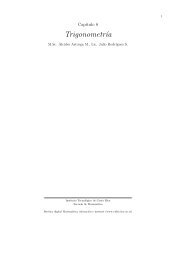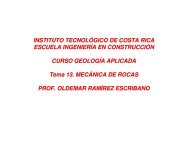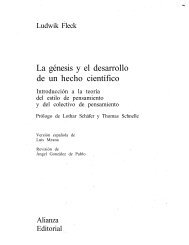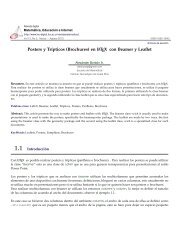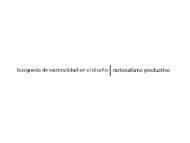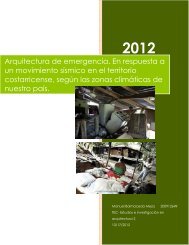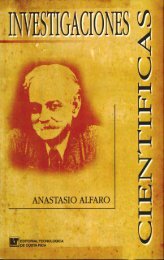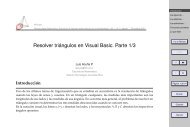- Page 2 and 3:
INTRODUCCIÓN a la TEORÍA DE NÚME
- Page 4 and 5:
Contenido Prefacio 7 PART I INTRODU
- Page 6 and 7:
CONTENIDO 5 7.6 Acerca de los facto
- Page 8 and 9:
Prefacio Este es un libro introduct
- Page 10 and 11:
235711 131719 232931 235711 FUNDAME
- Page 12 and 13:
4 FUNDAMENTOS inducción matemátic
- Page 14 and 15:
6 FUNDAMENTOS 1 = 1 2 , 1 + 3 = 2 2
- Page 16 and 17:
8 FUNDAMENTOS Figura 1.8 Seis copia
- Page 18 and 19:
235711 2 131719 232931 235711 DIVIS
- Page 20 and 21:
12 DIVISIBILIDAD Nota 1: Si a,b ∈
- Page 22 and 23:
14 DIVISIBILIDAD (2) Si n no tiene
- Page 24 and 25:
16 DIVISIBILIDAD Tercer refinamient
- Page 26 and 27:
18 DIVISIBILIDAD Nota: Es convenien
- Page 28 and 29:
20 DIVISIBILIDAD Private Sub Limpia
- Page 30 and 31:
22 DIVISIBILIDAD Solución: El teor
- Page 32 and 33:
24 DIVISIBILIDAD 2.4.1 Algoritmo e
- Page 34 and 35:
26 DIVISIBILIDAD Así, r es una com
- Page 36 and 37:
28 DIVISIBILIDAD � 1 si x ≥ 0 E
- Page 38 and 39:
30 DIVISIBILIDAD “⇐”: Si d|c,
- Page 40 and 41:
32 DIVISIBILIDAD EJEMPLO 2.25 Podem
- Page 42 and 43:
34 DIVISIBILIDAD EJEMPLO 2.27 Reali
- Page 44 and 45:
36 DIVISIBILIDAD 2.24 Sean m y n so
- Page 46 and 47:
235711 3 131719 232931 235711 CONGR
- Page 48 and 49:
40 CONGRUENCIAS Solución: Existe k
- Page 50 and 51:
42 CONGRUENCIAS EJEMPLO 3.8 El 9 de
- Page 52 and 53:
44 CONGRUENCIAS En la actualidad ha
- Page 54 and 55:
46 CONGRUENCIAS EJEMPLO 3.11 La rel
- Page 56 and 57:
48 CONGRUENCIAS Inversos módulo m
- Page 58 and 59:
50 CONGRUENCIAS 3.6 Congruencias li
- Page 60 and 61:
52 CONGRUENCIAS EJEMPLO 3.20 Resolv
- Page 62 and 63:
54 CONGRUENCIAS Para probar la unic
- Page 64 and 65:
56 CONGRUENCIAS P(x) ≡ 0 (mod 2)
- Page 66 and 67:
58 CONGRUENCIAS 3.36 Un niño tiene
- Page 68 and 69:
60 POTENCIAS mod m Teorema 4.2 Si O
- Page 70 and 71:
62 POTENCIAS mod m Prueba: Usando l
- Page 72 and 73:
64 POTENCIAS mod m Así, ϕ(9) = 6
- Page 74 and 75:
66 POTENCIAS mod m Si mcd(i,n) �=
- Page 76 and 77:
68 POTENCIAS mod m Prueba: Como R =
- Page 78 and 79:
70 POTENCIAS mod m a a n−1 mod 22
- Page 80 and 81:
72 POTENCIAS mod m Q(x) ≡ 0 (mod
- Page 82 and 83:
74 POTENCIAS mod m Solución: Como
- Page 84 and 85:
76 POTENCIAS mod m 4.20 Muestre el
- Page 86 and 87:
78 RAÍCES PRIMITIVAS Y LOGARITMO D
- Page 88 and 89:
80 RAÍCES PRIMITIVAS Y LOGARITMO D
- Page 90 and 91:
82 RAÍCES PRIMITIVAS Y LOGARITMO D
- Page 92 and 93:
84 RAÍCES PRIMITIVAS Y LOGARITMO D
- Page 94 and 95:
86 RAÍCES PRIMITIVAS Y LOGARITMO D
- Page 96 and 97: 88 RESIDUOS CUADRÁTICOS En princip
- Page 98 and 99: 90 RESIDUOS CUADRÁTICOS (1) a es r
- Page 100 and 101: 92 RESIDUOS CUADRÁTICOS Para el c
- Page 102 and 103: 94 RESIDUOS CUADRÁTICOS (2) ¿Es 7
- Page 104 and 105: 96 RESIDUOS CUADRÁTICOS Entonces 1
- Page 106 and 107: 98 RESIDUOS CUADRÁTICOS Como p2
- Page 108 and 109: 100 RESIDUOS CUADRÁTICOS Ahora que
- Page 110 and 111: 102 RESIDUOS CUADRÁTICOS De aquí
- Page 112 and 113: 104 RESIDUOS CUADRÁTICOS � a com
- Page 114 and 115: 106 RESIDUOS CUADRÁTICOS 6.17 Usar
- Page 116 and 117: 108 ESTIMACIONES, ESTAD˝STICAS Y P
- Page 118 and 119: 110 ESTIMACIONES, ESTAD˝STICAS Y P
- Page 120 and 121: 112 ESTIMACIONES, ESTAD˝STICAS Y P
- Page 122 and 123: 114 ESTIMACIONES, ESTAD˝STICAS Y P
- Page 124 and 125: 116 ESTIMACIONES, ESTAD˝STICAS Y P
- Page 126 and 127: 118 ESTIMACIONES, ESTAD˝STICAS Y P
- Page 128 and 129: 120 ESTIMACIONES, ESTAD˝STICAS Y P
- Page 130 and 131: 122 ESTIMACIONES, ESTAD˝STICAS Y P
- Page 132 and 133: 124 ESTIMACIONES, ESTAD˝STICAS Y P
- Page 134 and 135: 126 ESTIMACIONES, ESTAD˝STICAS Y P
- Page 136 and 137: 128 ESTIMACIONES, ESTAD˝STICAS Y P
- Page 138 and 139: PARTE II INTRODUCCCION A LA TEORIA
- Page 140 and 141: 132 ALGORITMOS PARA EL MCD Al igual
- Page 142 and 143: 134 ALGORITMOS PARA EL MCD Teorema
- Page 144 and 145: 136 ALGORITMOS PARA EL MCD Así, De
- Page 148 and 149: 140 ALGORITMOS PARA EL MCD a = b ·
- Page 150 and 151: 142 ALGORITMOS PARA EL MCD � �
- Page 152 and 153: 144 ALGORITMOS PARA EL MCD 8.6 Inve
- Page 154 and 155: 146 ALGORITMOS PARA EL MCD import j
- Page 156 and 157: 148 NÚMEROS PRIMOS Y FACTORIZACIÓ
- Page 158 and 159: 150 NÚMEROS PRIMOS Y FACTORIZACIÓ
- Page 160 and 161: 152 NÚMEROS PRIMOS Y FACTORIZACIÓ
- Page 162 and 163: 154 NÚMEROS PRIMOS Y FACTORIZACIÓ
- Page 164 and 165: 156 NÚMEROS PRIMOS Y FACTORIZACIÓ
- Page 166 and 167: 158 NÚMEROS PRIMOS Y FACTORIZACIÓ
- Page 168 and 169: 160 NÚMEROS PRIMOS Y FACTORIZACIÓ
- Page 170 and 171: 162 NÚMEROS PRIMOS Y FACTORIZACIÓ
- Page 172 and 173: 164 NÚMEROS PRIMOS Y FACTORIZACIÓ
- Page 174 and 175: 166 NÚMEROS PRIMOS Y FACTORIZACIÓ
- Page 176 and 177: 168 NÚMEROS PRIMOS Y FACTORIZACIÓ
- Page 178 and 179: 170 NÚMEROS PRIMOS Y FACTORIZACIÓ
- Page 180 and 181: 172 NÚMEROS PRIMOS Y FACTORIZACIÓ
- Page 182 and 183: 174 NÚMEROS PRIMOS Y FACTORIZACIÓ
- Page 184 and 185: 176 NÚMEROS PRIMOS Y FACTORIZACIÓ
- Page 186 and 187: Apéndice A Implementación de una
- Page 188 and 189: 180 IMPLEMENTACIÓN DE UNA CLASE
- Page 190 and 191: 182 IMPLEMENTACIÓN DE UNA CLASE
- Page 192 and 193: 184 IMPLEMENTACIÓN DE UNA CLASE
- Page 194 and 195: Bibliografía [1] R. Carmichael. Th
- Page 196 and 197:
188 SOLUCIÓN DE LOS EJERCICIOS As
- Page 198 and 199:
190 SOLUCIÓN DE LOS EJERCICIOS d =


